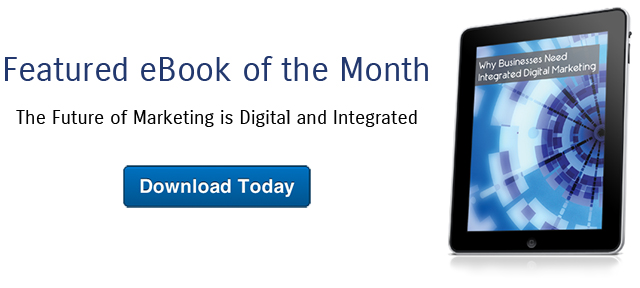 The widespread adoption of Internet, social, and mobile technologies has shifted power from the producer to the consumer. In this new “techonomy,” the increasingly sophisticated and highly-connected consumer expects more from brands; he or she wants personalization, relevance, convenience, simplicity, and proximity. To stay competitive, brands need a new approach to consumer engagement and conversion. They need an integrated digital marketing strategy.
The widespread adoption of Internet, social, and mobile technologies has shifted power from the producer to the consumer. In this new “techonomy,” the increasingly sophisticated and highly-connected consumer expects more from brands; he or she wants personalization, relevance, convenience, simplicity, and proximity. To stay competitive, brands need a new approach to consumer engagement and conversion. They need an integrated digital marketing strategy.
To help the reader fully appreciate the importance of integrated digital marketing, here is brief list of the top Marketing Trends for 2013; it represents a mash-up of my own thoughts coupled with everything I’ve been reading over the past year.
1. The Maturation of Mobile
Over 800 million smartphones and tablets will be sold in 2012 alone. As more people access the Internet via mobile, a company’s online assets (website, social media and online content) will need to play well on mobile devices of all shapes and sizes. As the rush to mobile continues, mobile-first marketing campaigns will become more prevalent.
2. Social’s Further Integration into Business
In 2013, even the Fortune 500 will have to get social. As people turn to social media to resolve customer service issues and inform purchases decision, brands will use social platforms to offer real-time interaction with prospects and customers. Businesses great and small will have to integrate social into their Web, eMail, and mobile marketing initiatives. Niche trends like social search (Google+), social video (YouTube), social shopping (Pinterest), and social branding (LinkedIn) will continue their march to the mainstream.
3. Consumers Fully Embrace Social, Local, Mobile
As users fully integrate smartphones and tablets into their daily routine, they’ll use social on mobile while local (I always thought “SoLoMo” should be “SoMoLo). Local-use apps, user-generated reviews, and mobile wallets will complement this movement. When meditating on user experience, brands will have to think convenience, simplicity, proximity, and even real-time marketing (sorry, gang- it’s going to be a busy year)
4. Content Marketing, Squared
As consumers begin to realize the possibilities of social, local, mobile, they’ll come to demand ever-more personalized content. Brands will have to oblige by creating contextually-relevant content that speaks to the wants and needs of each segment of their target audience. This, in turn, will hasten three emerging trends in content marketing: the widespread adoption of inbound marketing methodology, brands as publishers, and the use of robo content (not kidding).
5. From SEO to Targeted Discovery
As search engines like Google move to context-based algorithms that favor content over process, SEO will slowly morph into user-intent driven targeted discovery. The proliferation of specific-use social and mobile apps, socially-generated content (user-generated reviews), and predictive recommendations will upend the traditional search process, ushering in a new era of targeted discovery.
6. The Democratization of Big Data
2013 will see the fruits of big data filter down to SMBs. With ad retargeting, predictive recommendations, and location-based social and mobile marketing, small businesses will be able to employ sophisticated marketing tactics in a cost-effective manner.
7. Video and Audio Marketing for Consumer Engagement
Viral videos and webinars have been around for a relatively long time. 2013 will see businesses use video and audio as tools for online engagement and content marketing. Podcasts, audio-blogs, interactive video ads, video blogs, shoppable video, and social video productions that blur the line between advertising and content will all become part of the digital marketing mix in the coming year.
THE RISE OF INTEGRATED DIGITAL MARKETING
As these seven trends underscore, the growing size and complexity of the digital marketing landscape necessitates an integrated approach. Marketing silos must be torn down; communications processes must be re-worked; long-held paradigms must be shattered. Marketing orthodoxy needs to evolve to meet the formidable challenges of the new techonomy.
To respond to the higher sophistication and expectation levels of the hyper-connected consumer, businesses need integrated digital marketing
INTEGRATED DIGITAL MARKETING IN A NUTSHELL
The philosophy is simple: by establishing a seamless online presence over web, social, and mobile, and conveying relevant messaging promoted on eMail and social, businesses can attract new prospects and stay connected with existing customers.
Your Business Needs Integrated Digital Marketing
Today’s consumers expect personalization and seamless online user experiences. They’re looking for content that informs, entertains, or otherwise adds value to their daily lives.
To stay competitive, you must form meaningful connections with the people who matter most: those who find value in your brand.
You can do this by producing large quantities of original content that is exceptional, personalized, and relevant, optimizing it for any platform or device on which it could potentially be viewed or consumed via social sharing. You must then engage with your audience in real time over multiple channels. Finally, relying on user feedback and data analytics, you need to constantly tweak your brand’s message to fit the ever-changing demands of each segment of your target audience.
In other words, you need integrated digital marketing.
